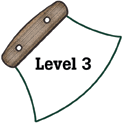
Alaska Science
Key Element B6
A student who meets the content standard should employ strict adherence to safety procedures in conducting scientific investigations.
 |
Alaska Science A student who meets the content standard should employ strict adherence to safety procedures in conducting scientific investigations. |
|
Performance Standard Level 3, Ages 11–14
|
|
|
|
Sample Assessment Ideas
|
|
|
Expanded Sample Assessment Idea
|
|
Procedure Students will:
Reflection and Revision
|
Levels of Performance |
||
|
Stage 4 |
Student work is complete, correct, and shows evidence of elaboration, extension, higher-order thinking skills, and relevant knowledge. Students make appropriate revision to their own work and recommends appropriate changes to the work of others. | ||
|
Stage 3
|
Student work is generally complete though it may contain minor inaccuracies in the relevant knowledge. The work shows limited evidence of elaboration, extension or higher-order thinking skills. Students make some revision to their own work or recommend changes to the work of others. | ||
|
Stage 2
|
Student work is incomplete, inappropriate or incorrect. Revision to their own work or recommendation about the work of others, if included, is minor and insignificant. | ||
|
Stage 1
|
Student work may be on topic, but does not address the question of community safety in a meaningful way. Student does not revise work or review the work of others. | ||
Standards Cross-References
|
||
|
National Science Education Standards The potential for accidents and the existence of hazards imposes the need for injury prevention. Safe living involves the development and use of safety precautions and the recognition of risk in personal and social dimensions. (Page 168) Risk analysis considers the type of hazard and estimates the number of people that might be exposed and the number likely to suffer consequences. The results are used to determine the options for reducing or eliminating risks. (Page 169) Individuals can use a systematic approach to thinking critically about risks and benefits. Examples include applying probability estimates to risks and comparing them to estimated personal and social benefits. (Page 169) Important personal and social decisions are made based on perceptions of benefits and risks. (Page 169) |
Benchmarks One common aspect of all social trade-offs pits personal benefit and the rights of the individual, on one side, against the social good and the rights of society, on the other. (Page 166) |
|
Table of Contents | Return to Alaska Native Knowledge Network